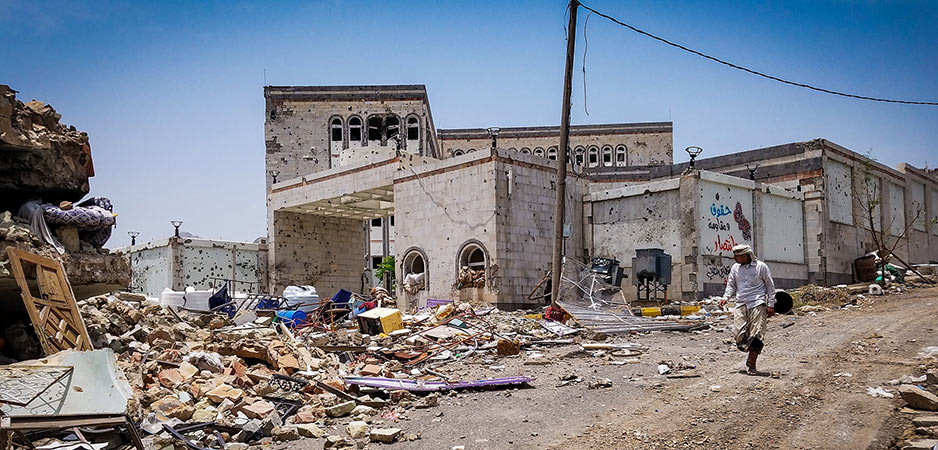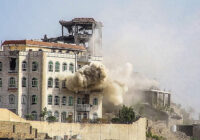Early on July 13, the Houthi rebels launched their second coordinated attack on Saudi Arabia in 20 days. The Saudi-led coalition said it intercepted and destroyed four ballistic missiles and six explosive drones that had been launched from the Houthi-controlled Yemeni capital Sanaa. While the Saudis did not inform the location of the missile and drone attacks, a Houthi military spokesperson stated they were directed at “military aircraft, pilot accommodation and Patriot systems in Khamis Mushait, and other military targets at Abha, Jizan and Najran airports” and destroyed a number of those targets. He added that “the giant oil facility in the Jizan industrial zone” was also targeted, and that the “strike was accurate.” Additionally, the rebels claimed to have killed and injured dozens of Saudi military officers.
The new coordinated attack, which followed the airstrikes against targets that included the Saudi defense and intelligence headquarters and King Salman air base on June 23, aiming for military sites and equipment with the addition of an oil facility, shows that the Houthis are stepping up their offensives against the Saudi-led coalition. The rebels claimed the attack was a retaliation against Saudi aggression, the latest of which was an airstrike on the Hajjah governorate that killed seven children and two women on July 12.
Is Saudi Arabia Looking for an Exit from Yemen?
Although the Saudi airstrike indeed provoked Houthi retaliation, another large-scale attack of that sort was already expected, and more are likely to come. With these two attacks, the Houthis have gained momentum based on their alleged ability to hit targets with high precision deep within Saudi Arabia, namely in Riyadh, and strike multiple targets in different cities at the same time. The Iran-backed group likely intends to push the Saudi-led coalition to approach ceasefire talks more seriously and consider concessions that the Saudis have so far deemed unnegotiable, such as the lifting of the sea, land and air blockade of Yemen.
The Push for Marib City
Tied to the Houthis’ intention to force the Saudi-led coalition to agree to better terms for a ceasefire is the rebels’ continuing push to capture Marib city, the Yemeni government’s last stronghold in the north of the country. On June 29, Houthis and pro-government fighters clashed in the Hashia district of Marib province, and on July 1, the Saudi-led coalition carried out airstrikes on the governorate, which is mostly controlled by the Houthis, except for parts that include its capital of the same name. Following the initial session (on July 7) of the trial of Houthi leaders accused of orchestrating the takeover of the Yemeni government, the Iran-backed group launched a ballistic missile that reportedly landed in a civilian area of Marib city on July 8, followed by another strike on July 14.
The Saudis have been wanting to withdraw from the Yemeni conflict for quite some time now. But they cannot allow a complete Houthi takeover of the northwest and, without Saudi presence, possibly even further, as this would give the rebels more bargaining power ahead of eventual direct negotiations. After Houthi forces captured the city of al-Hazm, in al-Jawf province, in March, the rebels gained access to a pathway through the al-Ruwaik desert where they would be able to send fighters directly to Marib and/or carry out additional airstrikes on the city.
Considering the danger of that threat, army troops announced in late June that they had surrounded al-Hazm, and on July 15, the coalition allegedly carried out air raids on the city that killed several civilians, increasing pressure as it is aware of the strategic importance of the city in a potential Houthi takeover of Marib.
It is highly unlikely that either of the two warring parties will achieve a complete military victory in Yemen. The Houthis will likely continue with their escalation approach hoping to capture Marib city so that they can increase their leverage ahead of eventual direct negotiations with the Saudi-led coalition, which are being pursued by the UN envoy for Yemen, Martin Griffiths. The coalition, in turn, will likely continue striking Houthi-controlled areas responding to the rebels’ attacks and keep on defending its last stronghold in the north, but, at some point, it will need to address ceasefire talks for the sake of the internationally recognized Yemeni government.
Should the coalition decide to wait and see if the tables are turned in the conflict, in which at the moment Houthi forces enjoy the upper hand militarily, and continue to refuse to grant Houthis legitimacy, the Saudi-backed government might be perceived by the international community as one of the pieces hindering a successful political process in Yemen. That is not to say that the Houthis are facilitating the process, but the Yemeni government has more to lose in terms of legitimacy simply because it is the governing entity recognized worldwide.
Endless fighting, with constant accusations of violations of international humanitarian law against the Saudi-led coalition, which currently amount to over 500 since 2015 according to the UK government, could eventually wear out the support for the government and its international legitimacy — the only thing knowingly corrupt President Abd-Rabbu Mansour Hadi still holds onto — might start to fade.
Undivided Attention
In the south, the latest developments involving the Abu Dhabi-backed Southern Transitional Council (STC) may affect the landscape of the war. The STC has been involved in on-and-off fights with the Saudi-led coalition for control of the south even after the power-sharing Riyadh Agreement the two parties signed in November 2019 and the announcement of a ceasefire in June. On July 26, however, the STC and the Yemeni government agreed on another attempt for the implementation of the Riyadh Agreement following a Saudi proposal to “accelerate” its fulfillment.
According to Yemeni media, the new deal brings similar points, such as the appointment of a governor and security director for Aden and the formation of a new cabinet with equal representation from both the north and the south, with new conditions, like the return of the governor of Socotra to the island and the revocation by the STC of its declaration of self-rule.
The alleged adaptation of the Riyadh Agreement, the materialization of which is still to be seen, and the consequent reduction of tensions between the two parties would ultimately damage Houthi plans, since the Iran-backed group was likely taking advantage of the fragmented attention given by the coalition to the fight against the STC in the south and the Houthis themselves in the north. The question that remains is whether the now undivided coalition’s attention to the fight against the Houthis in the north, provided the new conditions with the STC bring stability to the south, will enable it to turn the table in the conflict.
Looking ahead, there is a big chance the Houthis will continue to pressure the coalition, especially with offensives in and around Marib city and potentially in Saudi Arabia. Previous experiences show Houthi attacks are likely to continue even after the reported understanding between the coalition and the STC based on the fact that the June 23, Houthi-coordinated attacks on Saudi Arabia came a day after the coalition and the STC had announced a ceasefire. Meanwhile, if focused on the fight against the Houthis, the coalition might be able to respond to attacks with more vigor and prevent the rebels from increasing their leverage ahead of eventual direct negotiations.
*[Gulf State Analytics is a partner organization of Fair Observer.]
The views expressed in this article are the author’s own and do not necessarily reflect Fair Observer’s editorial policy.
Support Fair Observer
We rely on your support for our independence, diversity and quality.
For more than 10 years, Fair Observer has been free, fair and independent. No billionaire owns us, no advertisers control us. We are a reader-supported nonprofit. Unlike many other publications, we keep our content free for readers regardless of where they live or whether they can afford to pay. We have no paywalls and no ads.
In the post-truth era of fake news, echo chambers and filter bubbles, we publish a plurality of perspectives from around the world. Anyone can publish with us, but everyone goes through a rigorous editorial process. So, you get fact-checked, well-reasoned content instead of noise.
We publish 2,500+ voices from 90+ countries. We also conduct education and training programs
on subjects ranging from digital media and journalism to writing and critical thinking. This
doesn’t come cheap. Servers, editors, trainers and web developers cost
money.
Please consider supporting us on a regular basis as a recurring donor or a
sustaining member.
Will you support FO’s journalism?
We rely on your support for our independence, diversity and quality.






